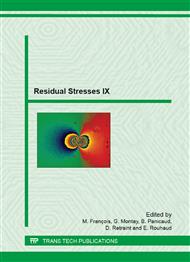p.203
p.209
p.215
p.221
p.228
p.234
p.243
p.249
p.256
X-Ray Optics and Precision Requirements for Residual Stress Analyses with High Spatial Resolution
Abstract:
In recent years, the demand for high spatial resolution in X-ray residual stress analysis has drastically increased. The locations of interest are frequently small foot radii of teeth of gears. Also the inner surface of holes or hollow cylinders in general with small diameter must be investigated after opening the cylindrical cavities. In resolving such measuring problems, significant progress has been made in reproducibly manufacturing and applying glass capillary X-ray optics. With focusing elliptical polycapillaries and conventional laboratory X-ray sources, spot sizes of few 10 μm can be realized at sufficiently intensities for residual stress analyses. However, glass capillary optics require refined alignment strategies which are completely different from those for conventional beam shaping optics. Moreover, the small spot sizes cannot be aligned and positioned on the sample surface by eye. Microscopy fixtures are required. Finally, measurements in small radii result in high precision requirements for the diffractometers as well as for the sample positioning in axes and directions which are significantly less relevant when measuring on plane surfaces. The specific requirements resulting from residual stress analyses with high spatial resolution using glass capillaries and small spot sizes at curved surfaces are described and discussed.
Info:
Periodical:
Pages:
228-233
Citation:
Online since:
August 2014
Authors:
Permissions:
Share:
Citation:


